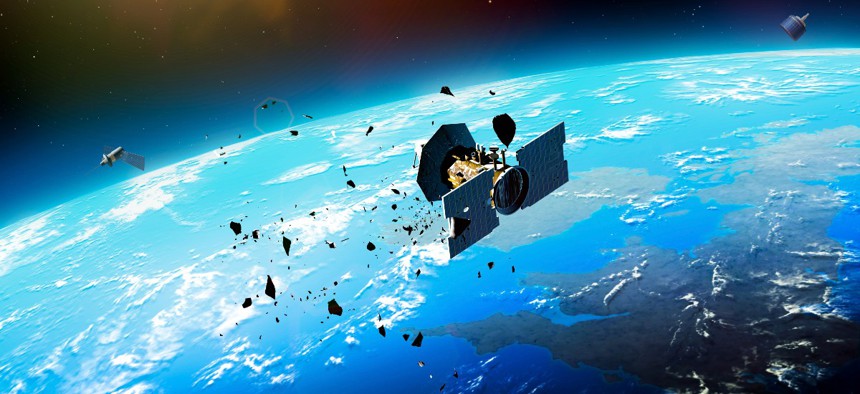NASA, FCC Address Growing Issue of Orbital Debris

MARK GARLICK/SCIENCE PHOTO LIBRARY/Getty Images
The agencies are respectively funding research to study this issue and proposing new rules to reduce debris in space.
With more than 4,800 satellites in orbit as of the end of 2021, NASA and the Federal Communications Commission are separately addressing the growing issue of orbital debris through funding research and proposing new rules, respectively.
According to NASA, orbital debris “consists of human-made objects orbiting Earth that no longer serve a purpose, including mission-related and fragmentation debris, nonfunctional spacecraft, and abandoned rocket stages.”
NASA is funding three research proposals from university-based teams over the next year “to analyze the economic, social and policy issues associated with space sustainability,” an announcement on Tuesday stated. Each award is between $50,000 and $100,000, according to a NASA spokesperson. NASA noted that orbital debris can be dangerous to spacecraft, threaten access to space and hinder the development of a low-Earth orbit economy, which includes commercial participants.
The chosen proposals are: “Adaptive Space Governance and Decision-Support using Source-Sink Evolutionary Models,” submitted by researchers from the Massachusetts Institute of Technology and the University of Texas-Austin; “An Integrated Assessment Model for Satellite Constellations and Orbital Debris,” submitted by researchers from the University of Colorado-Boulder and the Secure World Foundation; and “Communication and Space Debris: Connecting with Public Knowledges and Identities,” submitted by researchers from the University of Central Florida.
“Orbital debris is one of the great challenges of our era,” Bhavya Lal, associate administrator for NASA’s Office of Technology, Policy, and Strategy, said. “Maintaining our ability to use space is critical to our economy, our national security and our nation’s science and technology enterprise. These awards will fund research to help us understand the dynamics of the orbital environment and show how we can develop policies to limit debris creation and mitigate the impact of existing debris.”
NASA will make the research results publicly available on its website. The agency also noted that chosen teams can work with the international Organization for Economic Cooperation and Development as part of international efforts to address orbital debris and space sustainability.
Meanwhile, the FCC is also taking steps to address orbital debris. Specifically, Chairwoman Jessica Rosenworcel proposed new rules last week to address the increasing risk of orbital debris, which would replace longstanding guidelines.
“Since 1957 humanity has put thousands of satellites into the sky, often with the understanding that they were cheaper to abandon than take out of orbit,” Rosenworcel said. “These satellites can stay in orbit for decades, careening around our increasingly crowded skies as space junk and raising the risk of collisions that can ruin satellites we count on. Today, it is the recommended practice for satellite operators to deorbit their spacecraft within 25 years of completing their missions. But there is no reason to wait that long anymore. Our space economy is moving fast. For it to continue to grow, we need to do more to clean up after ourselves so space innovation can continue to expand. That is why I am proposing to shorten the 25-year guideline to no more than five years. It will mean more accountability and less risk of collisions that increase debris. I hope my colleagues will join me in supporting this effort.”
The proposal would require satellites that end their mission in or pass through the low-Earth orbit region––below 2,000 kilometers in altitude––to deorbit as soon as possible, but within five years of completing a mission. The proposal states that the FCC will consider whether shorter disposal requirements are necessary for large satellite constellations.
The FCC is set to vote on this proposed rule at its monthly meeting held on Sept. 29.






